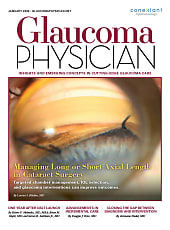Few improvements have impacted human life as digital-aided design has, allowing us to greatly increase productivity and indeed enjoy our work, family, and leisure time more. From tennis racquets to personal blenders to supercars, digital design permeates our existence. Spectacle lenses are not an exception to this rule. Within the scope of optical lenses, no single advancement has made a more positive impact than digital-aided design and manufacturing. Digital design has allowed us to create amazingly precise progressive lenses and single-vision optics. Among the most advanced digital designs stands Essilor’s Eyezen portfolio of lenses. These lenses include the Eyezen Start, Eyezen Kids, and Eyezen+ designs. In this article, we explore the technology and importance of these designs and start to understand how we can use this new technology to differentiate our practices and improve our patients’ lives.
Not Your Standard Single Vision
One of the most frequent questions I receive from patients and even optometrists and newer staff is: “If this is a single-vision lens, how is it different from any other conventional single-vision lens?” My answer is always the same: “Think of how a digital screen is different from an analog one or how an 8k television screen is different from a standard 480p screen.” In much the same way that these digital displays let you see a brighter, clearer, and distortion-free picture, digitally designed and manufactured lenses allow more information in through our eyes to help our amazing brain do the most incredible thing: see clearer than ever before.
To understand why a little better, we also need to understand the differences between digital design and digital manufacturing techniques.
Digital manufacturing uses computer numerical control (CNC) lens “grinding.” This process allows labs to produce an incredibly exact representation of the manifest refraction, down to the 100th diopter.
Instead of scraping away lens material on 2 axis planes and then polishing the lens until clear, CNC allows us to manipulate the lens on 3 axes and change every millimeter of the lens separately, actually scooping out the lens material needed to achieve the power needed. The result is a lens that is almost clear, and only minor buffing is needed. Once the lens is finished, it is as accurate as the design can allow. This fact brings up a good point: digital manufacturing is only as good as the design input into the CNC. A good analogy is watching Teen Wolf II on Blu-ray: it’s a better picture, the sound is better, but the script is still Teen Wolf II. If the design is just okay, the lens will just be a more accurate example of okay.
But What if the Design Were Better?
Digital design is used to change the way that a lens functions in every radius and quadrant. It uses hypercomplex algorithms to allow lens designers and manufacturers to provide multiple optimized zones; provide compensation for wrap, tilt, and vertex; and even remove some distortions, such as fishbowl and pincushion. Often the design can be personalized to the wearer; we sometimes refer to this technique as “free-form” design. In short, any lens design can be digitally manufactured, but only a digitally designed lens can be customized and specialized. This design paves a way for innovation. To finish the analogy, think of when Disney remade its beloved Lion King into a live-action movie. Blending beautiful cinematography and computer aided animation in IMAX format, Disney turned a fun animated classic into a stunning visual marvel. However, it only worked because the story was the king. Disney started with a great design and, through the lens of digital design, made it stunning. So how can digital design be used to improve a single-vision lens?
Enter Essilor’s Eyezen Lens Design
The Eyezen design from Essilor is a true leap forward in single-vision optics. Eyezen lenses use 2 optimized zones of focus. Using Essilor’s Wavefront Advanced Vision Enhancement (WAVE) technology, providing wearers with improved sharpness, color contrast, and vivid details in their vision, along with the added blue-violet light filter and 5 levels of accommodative boost, Eyezen+ provides the highest level of visual comfort available. Let’s continue to break down this technology.
Technological Advancements of Eyezen Lenses
The dual optimized zones in the Eyezen Start lens function to relax the wearer’s eyes in the near accommodative zone while providing the most accurate and widest-distance field of view. These zones are welcome news not only for any emerging or moderate presbyopic patient but also for kids, teens, and young adults in their 20s and 30s.
In plain language, if your eyes aren’t being strained while in downward gaze but instead are looking through an enhanced near zone, then the eyes will relax, and vision will be more natural and comfortable. If the eyes are also allowed to relax further with a slight accommodative power boost, then viewing near objects such as smartphones and tablets becomes effortless. The accommodative boost found in all Eyezen+ lenses is particularly beneficial for early to moderate presbyopic patients, because it helps to reduce the strain on the eyes when they are focusing on close-up tasks, making it easier to switch between different viewing distances.
Blue-Violet Filtering
Many clinical studies have linked exposure to high-energy blue-violet (HEBV) light to eye strain and discomfort, as well as retinal damage. Blue-violet light is that range of visible electromagnetic energy between 400 nm and 455 nm. Eyezen lenses come complete with a blue-light filter that reduces HEBV light more than blue-violet antireflective coatings alone, while allowing the good blue light back into our world. This goal is accomplished without the color distortion from yellow and melanin-type filters, giving your patients protection they can feel without having to see it.
Wearability and Satisfaction
The best technology can go by the wayside if it is not adapted. Examples of this fact abound in the optical field, including Empower smart segment glasses and Google Glass, to name only a couple. Eyezen lenses are trialed and preferred by those who have worn them. In a 2016 double-blind, home-use test conducted by the University of Arkansas with 121 participants, including 40 single-vision lens wearers, 3 out of 4 prescription eyeglass wearers preferred Eyezen lenses to their own single vision eyeglasses. The study also demonstrated that 4 out of 5 prescription eyeglass wearers preferred lenses with Eyezen+1, 2, or 3 to their own eyeglasses when using digital devices.1 Simply put, your patients will like it, so they will use it.
How Can We Use This New Technology To Enhance Our Practices?
With 5 levels of accommodative boost, there are solutions for many of your patients, from late-night teen gamers to soccer moms juggling 3 different calendars with moderate presbyopia. I have dispensed Eyezen with confidence to college students, soccer moms on the go, business professionals, and the deniers. You know the ones: the ones who “just take off their glasses to read.” By showing the need and then matching the need to available technology, we can give our patients real solutions. The boosts range from +0.40 D for the Eyezen+1 all the way to +1.01 D for the Eyezen+4. They come in plastic, AirWear, and other popular materials and can be paired with Xperio UV polarized and Transitions lenses, all with Crizal antireflective to produce the best-looking lenses.
It certainly should be noted that these lenses are still single-vision lenses and do not have the overall range of the very best progressives. However, they are very versatile and can be molded to solve the sometimes very specialized problems of each patient.
Off-Label or Right Strategy
Consider the outdoor adventurer who’s in their late 30s to early 40s. By giving them a +0.85 D or +1.01 D accommodative boost, they are gaining the ability to see the beauty of the outdoors more crisply and with more vibrant color, and to be able to quickly read their GPS or smartphone with a glance. Since the sun is the main source of HEBV light, they are also protected from blue light. Eyezen is also available in polarized and variable tint options. Many outdoor enthusiasts are intimidated by progressive lenses, and the Eyezen+ single vision lens allows them to see the world without the limitations of progressives.
- Cycling enthusiasts gain up to 30% wider fields of view and can see their display with little effort.
- Fishing enthusiasts can tie a new line without struggling and can see their catch with a polarized filter that enhances color and clarity.
- The scratch golfer can read the green with confidence and have the right light filter with Transitions lenses, while being able to keep their score on the up and up.
Whether your patient is a gamer, golfer, or denier, Eyezen lenses have a solution. Giving the lenses a try with your patients could help you stand apart from your competition.
Reference
1. Essilor informational brochure, 2018. Available at https://www.essilorpro.com/content/dam/essilor-pro/product-resources/eyezen/Eyezen%2B_Lenses_Overview.pdf
Disclosure: Mr. Becker states he has no relevant disclosures.









